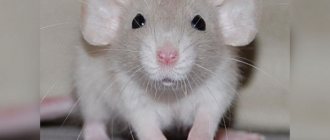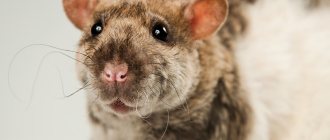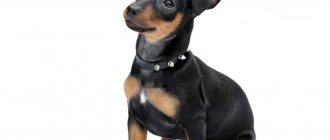Dumbo rats are definitely different from regular house rats. The most obvious difference is their ears, which are located much lower on the head than usual, giving the animal a pleasant and innocent appearance. These rats have a few other minor differences that may be related to temperament.
These animals got their nickname because they have very large ears, like the elephant in Dumbo. In this article we will get to know these cute animals better.
Dumbo rat. Description, features, types, care and price of the Dumbo rat
Dumbo rat can be no less exciting . Sociable pets take up little space and do not require special care or expensive food. The Californian breed of rat pups, bred in 1991, is named after the cartoon character “Dumbo” - a baby elephant with huge ears. Children adore this cute animal.
Description and features
Choosing a pet among the varieties of dumbo rats will not be difficult. The pups have won recognition for their friendly nature and funny appearance. Animals with big ears are not just cute creatures, they are trainable, sociable, and incredibly smart.
It is easy to distinguish dumbo rat pups from their relatives by the following characteristics:
- the head is wider than that of “relatives”;
- slightly protruding nape;
- pear-shaped body;
- a pointed muzzle with round beady eyes on both sides.
The rounded ears of the rat are set low - this is reflected in the breed standard. The value of each specimen is measured by the size of the ears: the larger, the more expensive the animal. The structure of this organ is of two types:
- “tulip” – petal-shaped, curled, pointed;
- “saucers” - flat, round.
The first type of baby rats, with petal ears, is more common in European countries. If you press the animal behind the ear, the shell opens up like a flower. In practice, pets are chosen not only by their ears, but also taking into account color and species preferences. The tails of animals come in different lengths, the fur depends on the type of rodent.
The decorative rat Dumbo is not inferior to the parameters of its relatives: the weight of an adult male is 300-500 g, body length is 18-20 cm. Females are smaller in size: weight is approximately 250-400 g, length is 15-18 cm.
Eared pets with outstanding breed characteristics are difficult to find. Decorative Dumbo rat pups, although they themselves do not have obvious “ears,” can give birth to offspring according to the conditions of the breed standard.
In captivity, the domestic rat Dumbo quickly gets used to its owner and responds to its name. It is recommended to name pets briefly and sonorously: Bonya, Sonya, Ksyusha, Knopa - females, Pete, Tosha, Garik, Bucks, Rocky - males.
The rodent will perceive the sound of the owner's voice as a call to run towards him. Hand training will help you return your pet to the cage after active games. Young animals are curious and active, older rat pups value peace - they love to sit on laps or shoulders, warming their owner with warmth.
The Dumbo rat is a clean animal, this is manifested in litter box training and daily self-cleaning. Attachment to family members brings harmony to the life of the little creature and those who take care of the dumbo.
Choosing a name for the rat Dumbo
Owners want to give intelligent puppy Dumbo a deep and meaningful nickname in hopes that the pet's name will influence the funny pet's personality and intelligence. Sometimes it can be difficult to immediately name a pet with a suitable name that emphasizes its individuality and expresses the love of its owner.
It is recommended that you take a few days to take a closer look at the habits and character traits of the new family member; most likely, he himself will tell the owner what to call him. The baby's furry name can be associated with the color and funny ears of a rodent, human associations and funny faces of a pet, favorite book and cartoon characters or pop stars. The rodent's name should be simple and easy to pronounce in lowercase letters. It is believed that females respond best to nicknames beginning with the letters K, M and D. Males prefer names with the letters C, K, M and D, animals with ears are more willing to get used to nicknames with the letters T, H, L, M , K, S, W and R.
The name for dumbo rat girls can be: Knop, Scully, Masya, Dana, Molly, Ksyusha, Martha, Alice, Dasha, Klava, Matilda, Gina, Darcy, Alpha, Kayla, Linda.
The name of a stupid rat can be: Kuzya, Tyson, Tim, Rocky, Simson, Garik, Steve, Venya, Bucks, Rocky, Dick.
It doesn’t matter what the owner calls the smart and eared guy. In any case, the stupid rat will sincerely adore and faithfully wait for its beloved owner, giving him his incredible tenderness and selfless love.
Types of dumbo rats
Among the diversity of species, everyone will find a companion to suit their taste. All animals are interesting in their own way.
Dumbo rex. A distinctive feature of the species is the curly fur. From a distance, the lop-eared rodent resembles a fluffy toy. The animal's curled antennae create a funny look. If you take the animal in your hands, you can see thick and wavy fur, hard to the touch.
Dumbo rex rats come in different colors: tri-color, white, gray, black.
Dumbo sphinx. A win-win option for pet owners with allergies. Rats have no hair. Bare folded skin evokes tenderness and tenderness in the soul towards defenseless animals.
Sometimes sparse hairs are observed on the head, back, and paws. Skin color can be black, white, pinkish, bluish, even chocolate. It is pleasant and silky to the touch. The antennae are small and slightly curled. The appearance of hairless rat pups is associated with the action of mutated genes.
Dumbo Siamese rats. The self-explanatory name reflects the color feature characteristic of Siamese cats. The tail, paws, and muzzle, painted in dark tones, contrast with the whitish coat on the rodent’s body.
The offspring of Siamese rat pups may not get the same colors. Unlike other species, the nature of the animals is capricious with aggressive manifestations. It is not recommended to have a pet for small children.
Dumbo Husky. A rare breed of rodents, also called chameleons. The name is borrowed from a famous dog breed. It is noteworthy that babies of this species are born in the usual colors: white-gray, brown, black. Over time, growing pups change their fur coat to a new one, diluted with snow-white touches.
Manx. A species of tailless animals obtained as a result of gene mutation. When purchasing this species, you can be deceived by dishonest sellers who offer ordinary animals with docked tails after birth.
Blue mink. A rare breed that is difficult to find. The name conveys the characteristic color of a delicate blue hue.
The color and structure of the fur of rats of the same species may vary. The fur is often straight and velvety, less often curly or satin, when only the muzzle is covered with long hairs. In addition to traditional colors (gray, brown, black), there are rare animal colors - mosaic, topaz, amber.
Differences from wild rats
While ornamental rats are very similar to their wild relatives, there are significant differences between them. The most noticeable difference is the appearance. Random mutations (mostly in color) can occur in the wild, but are rare.
Decorative rats are calmer and less aggressive towards humans due to breeding and, as a result, the constant selection of producers with the desired set of behavioral qualities. However, ornamental rats, like any other domestic animals, can become wild and over several generations produced in natural conditions, their behavior and attitude towards humans can become indistinguishable from initially wild rats. This phenomenon is regularly encountered by rat lovers who are engaged in catching colonies or families of decorative rats that find themselves on the street.
Decorative rats have greater body weight and fertility. They are less afraid of new products, they have a calmer reaction to light and sound, and neophobia is less developed. Wild rats are mainly nocturnal, sometimes going out during the day in search of food. In domesticated rats this is not so pronounced. In a fight, wild rats produce sharper screams than domestic ones. In addition, a wild rat that loses a “battle” almost always runs away from the winning one, while domesticated rats can behave differently after a fight.
Domesticated rats live longer than wild ones. This is because kitty rats are protected from predators and always have access to food, water, shelter and veterinary care. Their average lifespan is approximately 2–3 years, unlike wild ones, which on average live less than 1 year. Wild rats have larger brains, hearts, livers, kidneys and adrenal glands. However, decorative rats, like wild ones, are susceptible to many different diseases, among which a special place is occupied by the respiratory syndrome of mouse-like rodents (respiratory diseases of various etiologies), as well as various neoplasms (tumors of the mammary glands, brain, etc.).
Colors
The color of animals of this breed variety, as well as the length and quality of the coat within the species, can vary greatly. Most often there are individuals with short, velvety, straight hair in gray, white, black and chocolate colors. Rare colors of dumbo rats are Siamese, amber, topaz, and mosaic (tricolor).
Amazingly beautiful Dumbo rat of blue mink color. You can find it only from large breeders at a price that is quite high for decorative rats.
Scientists, by crossing rodents of the Dambo breed variety with decorative rats of other breeds, managed to obtain new subspecies that deserve the attention of amateur rat breeders.
Dumbo rats have the following subspecies:
- What kind of snakes are kept at home?
- Ancient dog breeds
- Dog's sense of smell
- Maine Coon
- Domestic iguana
- How much does a raccoon cost?
- Sphynx - can be white, blue, chocolate and black. Their body is completely devoid of vegetation. There is some hair on the back, paws and head. There are either no mustaches at all, or they are very small and curled upward. Suitable for people with allergies;
- rex - on the contrary, has thick, wavy and fairly stiff hair;
- Husky is a chameleon rat. Only it has the amazing ability to “bloom” - to change color with age. Babies are born of a standard color - black, gray, red, etc., but with age, their fur is diluted with white hairs - so that, born black, a rat pup, having matured, turns into a snow-white miracle. Their ideal color is “salt and pepper.”
Rats are very similar to people - they can dive and swim, are subject to stress and psychological shocks, dream, are afraid of tickling and can laugh, albeit in the ultrasonic range.
Experienced rat breeders know how long domestic Dumbo rats live. And you won’t be able to please beginners with the length of your pet’s life – you need to immediately get used to the idea that your pet will stay with you for about 2-4 years. Thanks to good care and nutrition, many manage to extend their life by a year and a half, but no more.
Care and maintenance at home
Caring for tame animals is not difficult. They take up very little space, and caring for dambos does not require any expense. To ensure a comfortable existence for pets, you should take into account some features of the life of eared babies.
Dumbo rats are inquisitive and intelligent. They are superior in intelligence to hamsters and guinea pigs. They waddle like penguins. Their physique does not allow them to run fast, but the animals take walks and mark their territory.
Owners need to take into account that while traveling around the house, rodents will taste everything they come across on the way. Walks must be supervised; animals spend most of their time in cage houses.
Housing for one pet can measure 60 cm in width, length and height. An open aquarium is not suitable, as animals can get out of it. High jumping half a meter is not a record for them. A wire cage with a plastic tray and shelves will be especially cozy if you put a house in it for a relaxing holiday.
Rodents love to be alone and feel protected. The bottom is covered with wood filler; sometimes napkins are spread underneath for ease of cleaning. It is preferable to use shavings, not sawdust, which enter the animal's respiratory tract.
Hanging cups and nipple drinkers must be installed at a sufficient level taking into account the size of the pet. Dry and liquid food are placed in different bowls. A separate corner is allocated for a tray with filler. They won’t let your pet get bored and provide daily loads of stairs, a hammock, and a tunnel.
Nutrition
Rats eat almost everything, but the wrong food leads to diseases and allergies. Pets are especially susceptible to eating disorders.
A balanced diet includes:
- dry food, including millet, barley, oats, flax seeds, pumpkin;
- chicken, fish meat;
- dairy products: kefir, cottage cheese;
- greens in the form of dandelion leaves, parsley, dill;
- fruits: pear, banana (except unripe ones), plum.
Treating yourself to nuts will help grind your teeth. Sometimes animals can be pampered with dried fruits. Undesirable foods in the diet are:
- beet;
- cucumber;
- turnip;
- cheese (especially blue cheese);
- eggs;
- sour cream.
They can be offered in limited quantities no more than once a week.
Products strictly prohibited for consumption:
- sausages;
- sweets, including chocolate;
- spinach;
- raw potatoes;
- beans;
- rhubarb;
- cabbage.
Walking around the house is dangerous for pets due to encountering potted plants:
- Kalanchoe;
- Dieffenbachia;
- geranium;
- ivy;
- begonia;
- cyclamen;
- hydrangea;
- aloe;
- hydrangea.
It is important to monitor the freshness of the water in the drinking bowl and change it every day. Babies are fed 4 times a day, adult rats - 2 times.
Reproduction and lifespan
Young rat pups become sexually mature by 6 months. To produce offspring, animals with distinct species characteristics are needed. Pregnancy lasts 21-23 days. There are 8-12 babies in a litter. Rats are born blind, deaf, and naked. Not all newborns have large ears.
The development of the young is rapid. At 4 days the babies begin to hear, at 12 days they begin to see. When babies are 14-15 days old, they are ready to explore the world and communicate with people. From three weeks of age, Dumbo rats feed on adult food. At one and a half months, the pups are completely independent.
How long dumbo rats live depends largely on the conditions of their detention. The average life expectancy is 2-3 years. Caring for pets, proper care, timely treatment of diseases and a balanced diet prolong the life of decorative rats up to 4-5 years.
You need to purchase a purebred rat from trusted breeders so as not to be deceived by scammers. The Dumbo rat in the photo in the online store may be purebred, but the purchased specimen may turn out to be an ordinary decorative animal.
A guarantee of thoroughbredness can only be obtained in a specialized nursery. The price depends on many factors: rarity of the species, conditions of detention, purchase price, etc.
Specimens that appear due to a genetic failure become unique. In nature, such individuals do not survive, for example, albino rats. The cost of such animals is above average.
The price for one dumbo rat varies from 200 to 3000 rubles. Buying any pet is not just fun, but also a responsibility for a small eared miracle that brings the joy of communication.
Source
Diseases and treatment
It’s hard not to notice if your pet is unwell. A healthy rat has shiny fur, clear and clean eyes, and the animal is playful and active. If deviations in health status are observed, you should immediately contact a veterinarian.
The most common diseases of decorative rats:
- Mycoplasmosis . Infection occurs through airborne droplets and progresses to pneumonia. Deadly dangerous.
- Abscesses . Associated with injury to the animal. An opening and disinfection of the inflammation site is required.
- Development of benign and malignant tumors.
- Parasitic lesions. Rats are not dewormed. Treatment is carried out only if the disease is detected.
Decorative rats Dumbo - long-eared pets with a good-natured disposition
Content
Dumbos are pet rats with a cute face, large ears and a friendly disposition. Such pets are often owned by families with children. However, buying a rodent should not be taken lightly. First you need to learn about the features of its content.
Dumbo, unlike other rats, does not tolerate lack of communication well. If you don't pay enough attention to it, your pet may become wild or get sick.
Let's find out what this breed is and how to properly care for a cute animal so that it is healthy and cheerful.
Where is the best place to buy a rat?
When purchasing a decorative rat, future owners inevitably face the question of where is the best place to buy a pet. Experienced breeders recommend not to succumb to the temptation of purchasing an animal from your own hands at the cheapest price. It is better to pay the required amount and get a healthy rat with a good pedigree.
As a last resort, you can go shopping at a pet store. Even in the event of an unplanned pregnancy of a female, the rat pups can always be given away. But you won’t have to spend additional money on constant treatment of many diseases in expensive veterinary clinics. Moreover, most specialized stores have a good price/quality ratio.
Description of the animal
The Dumbo rat differs from the usual one in the fit and size of the ears. Its shells are much larger than those of its relatives and are set lower. Representatives of this breed have ears that are round, somewhat saucer-shaped, or petal-shaped. In the second case, they are elongated and have rounded ends.
The Dumbo rat is valued precisely for the size of its ears. The larger they are, the higher the cost of the animal.
The Dumbo rat breed was developed by American breeders in 1991. The animals came to Russia in 2001.
Appearance
The body size of the Dumbo rat is 15-20 cm. Males are much larger than females. The weight of a representative of this breed is 240-400 g.
- body is pear-shaped, stocky;
- the neck is short;
- wide head with a slightly protruding occipital part;
- elongated sharp muzzle;
- low set large ears;
- eyes look like beads;
- the tail is quite long, with a thick base (the breed also has a tailless variety);
- the coat can be smooth or curly, and there are also hairless representatives of the breed;
- Common colors are beige, gray, black, blue.
Character and habits
Dumbo rats have a friendly disposition. They quickly get used to their owner, willingly go to the hands and play. These are smart pets that can be trained to carry out various commands if desired.
Typical behavior and temperament
Dumbo rats are friendly and docile creatures. They are calm and inquisitive and can be affectionate towards people they trust. These rodents love to interact with their owners. However, it may take them a little time to get used to the new person.
These animals are also extremely intelligent and many people have trained their pets to perform tricks. They are social creatures, so they need regular interaction with people or other rats. Many experts recommend keeping at least two rats together at all times.
Varieties
Thanks to breeding work, several varieties of domestic dumbo rats have been developed. They differ in color and coat type.
Dumbo Rex rats have thick, curly fur. The cover is soft and silky. Little rats' fur does not curl, but sticks out in different directions, it looks very funny. In adult pets, formed curls can be seen. Mustaches can also curl.
Siamese
This is a very beautiful and rare variety with an original color, like a Siamese cat. The main shade of six is cream. There is a dark mask on the face and paws.
The gene that is responsible for this type of color is recessive, so it is passed on only to some cubs from the litter. This explains the high cost of Siamese rat pups.
Husky
Dumbo Husky rats are very popular. Pets with this color have dark fur of gray, brown or almost black color. As the animal grows, snow-white hairs appear, which are concentrated in the muzzle area, on the neck and abdomen.
Blue
Decorative blue Dumbo rats are very beautiful, so breeders often sell them at a higher price. These pets have light gray fur with a distinct bluish tint.
Manx
Domestic Dumbo Manx rats are the result of complex genetic mutations. This variety differs from others not in the type of coat or color, but in the absence of a tail.
Although the animal looks funny, life is hard for him without a tail. This part of the body is necessary to maintain balance. It also plays an important role in thermoregulation - the tailless rat often suffers from overheating. Therefore, for reasons of humanity, veterinarians are against breeding Manx cats.
Sphinx
These are unique representatives of the species that differ from their relatives in the absence of hair. The hairless Dumbo rat has numerous folds on its skin, like cats of the same breed. The vibrissae are underdeveloped and curled, but the standard allows for their absence.
Dumbo Sphinx rats require special housing conditions, as they are susceptible to colds and often suffer from skin damage.
Is it worth keeping a dumbo rat at home?
Dumbo rats are often adopted by those who are unable to keep another pet - a cat, dog or chinchilla. This animal can become a good friend.
But before you decide to buy a Dumbo rat, you should weigh the pros and cons:
| pros | Minuses |
| High intelligence | Having an unpleasant odor |
| Easy to care for | Poor health |
| Friendly character, sociability | Short life expectancy |
| Cleanliness | Dependence on communication with a person |
| Low maintenance costs | Cannot be kept with cats or other predators |
| Affordable price | |
| Undemanding to the food supply |
Obviously, the Dumbo rat has more advantages than disadvantages. This is why many people willingly get a cute animal.
Final cost table depending on the place of purchase
To make it easier to determine the price of a rat depending on the place of purchase and breed, you can use a special table:
| Breed | Cost, rub. | |||
| From hand | At the poultry market | At the pet store | From professional breeders | |
| Standard | 200-300 | 400-500 | 600-700 | 800-3000 |
| Fuzz | 700-800 | 900-1000 | 1200-1400 | 1500-2000 |
| Sphinx | 400-500 | 600-800 | 800-1000 | 1200-2000 |
| Blue standard | 350-500 | 500-700 | 700-900 | 900-1200 |
| Dumbo | 500-600 | 700-800 | 900-1000 | 1000-1500 |
| Rex | 600-700 | 800-900 | 900-1000 | 1100-1600 |
| Tailless | 1000-1300 | 1300-1500 | 1500-2500 | 2500-3000 |
It is worth noting that the table shows only approximate prices for rats of various breeds. Prices for fluffies may vary slightly at different retail outlets.
Care and maintenance
Dumbo rats do not require a lot of attention, but still need regular interaction and play. Those who are planning to get a long-eared animal should prepare carefully. You will have to not only arrange a comfortable home for him, but also study the recommendations of experienced breeders regarding nutrition, hygiene and taming.
Cage and filler
First you need to decide how many pets you plan to keep. One rat will be bored, because they are social animals. Usually they breed either two same-sex individuals, or a male and a female.
Two Dumbo rats will need a spacious cage, which consists of several floors. A multi-tier design takes up less space in the house, but the inside is more spacious, which allows pets to move more. The minimum cage size for a pair of rats is 60x40 cm. Recommended height is 50-70 cm.
All parts of the structure must be made of durable metal. A suitable width between the rods is 0.7-1 cm. The cage should be equipped with a plastic removable tray, as well as dividing partitions and ladders.
It is important that the cage door closes securely - Dumbo rats are quite smart, and it will not be difficult for them to get out.
Place for a cage
It is very important to choose a suitable place to place the cage. Dumbo rats are sensitive to drafts and dampness. In such conditions, the pet may catch a cold. His home should be placed so that direct sunlight and cold air flows do not penetrate inside. You cannot place the cage near heating radiators.
Attention! Suitable temperature conditions for dumbo rats are from +20 to +25 degrees. The humidity level should not exceed 70%.
Interior arrangement
A plastic rest house is placed in the cage. It is advisable for each dumbo rat to have its own hiding place. In addition, you will need two ceramic feed containers - one for grain, the other for wet and perishable food. The nipple drinker is fixed to one of the walls of the cage from the outside, and the spout is brought inside.
The Dumbo rat loves to spend time actively, so the home needs to be equipped with tunnels, stairs and several ropes. You will also need a hammock.
When choosing a running wheel, preference is given to a one-piece design - if the tail gets caught in the grate, the rat may get hurt. However, this piece of equipment often turns out to be superfluous - pets use it as a bed.
Filler
A thick layer of bedding is placed at the bottom of the cage. You can use wood shavings from deciduous and fruit trees. Pine sawdust is not suitable - it contains essential oils that cause allergies.
Some dumbo rat owners prefer corn litter. It is a little more expensive than shavings, but has better absorption capacity and eliminates odor well.
Hygiene
It is necessary to keep your pet's home clean. It is recommended to do cleaning 1-2 times a week, as the filler gets dirty.
- The old litter is poured out and the tray is washed with hot water.
- Clean the feeder and drinker in the same way.
- To remove heavy dirt and remove the smell of excrement, use a soda solution - do not wash equipment with other cleaning agents.
- The water in the drinking bowl is changed daily; it should always be fresh.
Dumbo rats are clean pets. They constantly wash themselves and lick their fur, so there is no need to bathe them.
Males secrete a secretion that smells bad. To get rid of the smell, you need to change the litter more often. In rare cases, you have to wash your pet if he has stained his fur with something that cannot be licked off.
Bath the dumbo rat in a small amount of warm water. Human shampoo is not suitable - you need to buy a special product for rodents. Firstly, it is easier to wash off, and secondly, it does not cause allergies. During water procedures, care must be taken to ensure that water does not get into the rat’s ear, as this can lead to inflammation.
After washing the pet, dry it with a terry towel. Until the fur dries, the rat should be in a warm place where there is no draft.
Taming
Dumbo rats quickly adapt to new conditions. During the first 2-3 days of your pet's stay in the house, it is better to leave it alone. He needs to get acquainted with his home, get used to the sounds and smells. When the little rat gets used to it a little, you can begin to tame it. It is important to devote at least 1 hour a day to this, otherwise all your efforts will be in vain.
You must act delicately so as not to frighten the rat. At first, you can simply talk to her through the cage and offer her a treat. This way the animal will get used to the smell of its owner’s hands. After a few days, you should try sticking your hand with a treat inside the cage. In this case, you should not make sudden movements. The Dumbo rat should sit on the palm itself.
When this becomes a habit, you can begin to let her out of the cage and gently pick her up. When it comes to taming, the main thing is regularity. It is necessary to communicate with the rat every day, then it will calmly react to the presence of its owner.
The next stage is learning commands. Dumbo are smart and intelligent rats, they can be trained. The pet can be taught to respond to a name and return to the cage. The main thing is patience, perseverance and no rudeness.
In order for the rat to remember its name, it is said every time you spend time with it. Moreover, you cannot distort its sound with the help of diminutive forms.
Once your rat remembers its name, it will be much easier to train it to return to its cage on command. To do this, you need to open the door and offer a treat. The pet will take it from your hand and return to its home. As soon as he enters the cage, you must say “Home!” This training is carried out daily until the Dumbo rat learns the lesson.
Filler
In addition to installing a solid layer on the bottom of the cage, you will also need to line it with some kind of substrate. Two popular options are recycled newspaper or aspen shavings. Although you can also use fabric, store-bought litter, or shredded cardboard.
Avoid using cedar or pine litter as they produce toxic fumes that can make your rat sick. You should also avoid cat litter. If your rat accidentally ingests it, it will clump together in the intestines and possibly kill the animal. Corn cob litter has the same problem, but can also become moldy and produce toxic spores.
No matter what type of substrate you use, you will need to clean your rat cage daily. This is to keep them healthy (and to keep your room from smelling like rat droppings).
Features of feeding
Dumbo rats are omnivores, but there are still some dietary restrictions. Pets are prone to allergies and, unlike their wild counterparts, sometimes suffer from digestive problems.
The basis of the diet of the dumbo rat is grain. Pet stores sell special food for small rodents, which includes:
- millet;
- barley;
- buckwheat;
- lentils;
- nuts;
- herbal granules;
- raisin;
- sunflower seeds;
- pumpkin seeds.
In addition to grain, Dumbo rats are fed boiled lean meat, offal, cottage cheese, and eggs. Rodents are not averse to eating vegetables and fruits. They love to eat carrots, broccoli, zucchini, cucumber, as well as apples, bananas and peaches.
Dumbo rats can be given fresh greens as an additional source of vitamins. The pet will like the leaves and shoots of dandelion, plantain, dill and wheat sprouts.
Not all food will benefit your pet rat. Many foods from the human table can harm the health of the animal. These are salty, spicy, fried, fatty foods.
Prohibited products include:
- semi-finished products;
- sausage, frankfurters;
- canned food;
- snacks;
- peas and beans;
- sweets;
- baking;
- fish;
- pork;
- vegetables - white cabbage, horseradish, radish and turnip;
- mushrooms in any form;
- cheese.
Dumbo rats can only drink filtered water and milk. Sometimes you can pamper your pet with low-fat kefir. There should be no sweet drinks in your diet.
Breeding
Puberty in Dumbo rats occurs at six months of age. However, there is no need to rush to crossbreed the female. Her body must be fully formed. It is better to wait a month or two, and then place the female with the male in order to obtain offspring.
Pregnancy lasts 21-23 days. There are from 6 to 12 cubs in one litter. Some dumbo rats have regular-sized ears, but when they become adults, they can give birth to long-eared offspring. The animals are born completely bald, blind and deaf. The mother feeds them with milk for 3 weeks.
Dumbo rats grow quickly. After four days, the babies begin to see. The rumor appears approximately on the 12th day after birth. Within 2 weeks, their bodies are covered with soft fur. At this age you can already pick them up. The right time to transfer dumbo rats to new owners is one and a half months.
The gender of a rodent can be easily determined by its nipples. In females they are located along the abdomen in two rows. Males do not have mammary glands.
The Dumbo rat is an ideal pet that does not require a lot of money to maintain. One of his undeniable advantages is his friendly character and strong affection for people. A funny animal can bring a lot of joy to its owner.
How to bathe a pet rat?
There are some rules that you need to know in order to buy a rat correctly, but each owner will figure out the nuances himself. During the first baths, it would be useful to have a second person present as additional insurance in case the animal gets scared.
- The room must be securely fenced off from drafts - rats catch colds quite easily.
- The water should be warm, but not hot.
- It is necessary to bathe the rat in a container with a small amount of water, especially if it is afraid to bathe. Ideally, the rat can stand in the water.
To wash, use a special shampoo for rats - this will not cause an allergic reaction and will make your pet’s fur smooth and shiny, and the special shampoo is easier to wash off.
Be sure to read the instructions - some shampoos require first diluting with water.
Be careful not to get the shampoo in the rat's eyes. Also, during bathing, it is necessary to ensure that water does not get into the animal’s ears; this is fraught with complications, including deafness.
Rats' skin is very delicate; for heavily soiled areas, you can use a very soft sponge, but it is preferable to use your hands. Massage the rat's fur as carefully as possible so as not to touch it with your nails.
After bathing, carefully dry the rat with a towel and then leave it to dry, preferably wrapped in another dry towel.
If you have several pets, the first time after returning from swimming, carefully monitor their behavior - when bathing rats, their natural smell is “washed away”, and relatives may not recognize their companion at first.
Remember that bathing rats is unacceptable if they have wounds or scratches on their bodies, or if the rat is sneezing or showing other signs of illness.
If only the tail or paws, for example, or a small area of fur are dirty, you can get by with “local” cleaning instead of a full bath.











